
Topaz, Utah

Map of the center |
 Monument at the camp. |
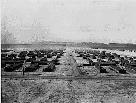
A panorama view of the Central Utah Relocation Center, taken from the water tower., 03/14/1943 |
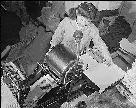 Rose Nakagawa, former student from San Francisco, California, now works as a mimeograph operator on the Topaz Times. |
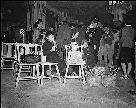 The arrival of the evacuees from Hawaii was a festive day, at this center. This family group is shown at a reception which was given in their honor. |
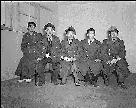
The full caption for this photograph reads: Topaz, Utah. A group of newly arrived evacuees from Hawaii are pictured in their new barracks home. These evacuees, upon arrival in San Francisco, were given army issue overcoats to protect them against the Utah cold. |
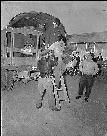
Evacuees from Hawaii were transported from Delta, Utah to this center in army trucks. A reception was held by the other residents in honor of the newly arrived. |
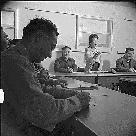
The only woman member of the Community Council, is shown arguing her point at a ameeting of the Community Council, which was held to make a charter for the residents of this War Relocation Authority center. |
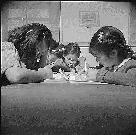
Pupils of the high first grade are shown busily at work on their geography lessons., 03/12/1943 |
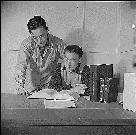
Victor Abe and Shozo Tsuchida, former law students from San Francisco, California, are members of the legal staff in the Project Attorney's office, at this War Relocation Authority center. |
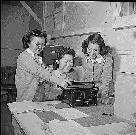
Tsuruku Takahashi, Kei Hasegawa, and Mary Suzuki, all former residents of San Francisco, California, and now working as stenographers in the Project Attorney's office. |
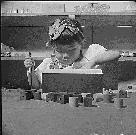
Educational games are part of the prescribed course of study in the nursery schools at this War Relocation Authority center, for evacuees of Japanese ancestry. |
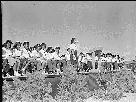
Scenes at graduation of 9th grade junior high class at Topaz., 06/25/1943 |
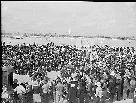
James Wakasa funeral scene. (The man shot by military sentry)., 04/19/1943 |
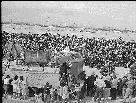
James Wakasa funeral scene. ( The man shot by military sentry)., 04/19/1943 |
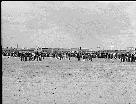
Scene at James Wakasa funeral, 04/19/1943 |
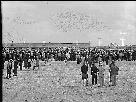
Scene at James Wakasa funeral, 04/19/1943 |
 Evacuees and appointed personnel bidding each other goodbye for the last time as the last bus load of Japanese Americans is ready to leave the center. |
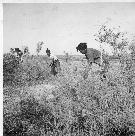 Volunteer workers clearing sagebrush and wild guayule from a section of the lands of the Topaz Relocation Center to be used for truck gardening and animal forage acreage. 10/27/42
|
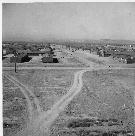 Looking down a main thoroughfare at the Topaz Relocation Center. 10/18/42 |
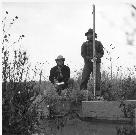 The weather was bitter as these young evacuee engineers began the task of laying out the irrigation system for the farming lands surrounding the relocation center. 10/20/42
|
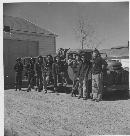 Evacuee firemen are shown posed beside their fire truck. Excellent work by this trained crew has minimized fire and fire damage in this War Relocation Authority Center for evacuees of Japanese descent |
 The Rev. E. Stanley Jones, Head of the Traveling Missionary Team, addresses assembled audience at Central Utah Relocation Center during visit on October 28, 1943. At speaker's table seated left to right are Dr. Skoglund, Rev. E. Stanley Jones, Dave Tatsuno and Mrs. Charles E. Ernst. 10/28/43
|
 A flat tire proved the undoing of this WRA passenger car at the Central Utah Relocation Center. The car loaded with ministers going into Delta to meet visiting ministers blew a tire and plunged into the ditch just east of projected area boundary. The accident occurred on the night of October 27, 1943. Miraculously none of the occupants were seriously injured. 10/27/43 |
 Back from the fighting front on furlough to visit their families at Topaz Relocation Center are (left to right): Ben Moriwaki and Fred Tanakatsubo. These fighting men saw real action during the campaign in Aleutians and were with the landing force which occupied Attu under heavy fire.
|
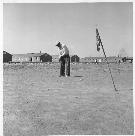 This former California tournament runner-up keeps his golf form by first preparing a short course and then spending all his spare time with his irons and putting clubs.. 10/19/42 |
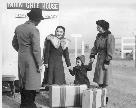 First Japanese-American family leaves Central Utah Relocation Center for California. Mrs. Saku Moriwaki, 33 (center), formerly of Berkeley, and her two year old daughter, Suga Ann, are bid goodbye at the gate by a Caucasian staff member and her sister, Mrs. Suga Baba. Mrs. Moriwaki has accepted a position in the home of Mrs. R. A. Isenberg (2175 Cowper Street), Palo Alto. Her husband, Pfc. Yoshiaki Moriwaki, former Berkeley insurance broker, is fighting the Nazis. . 1/3/45
|
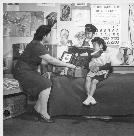 Daddy will be glad to know we're going home. So said Mrs. Marianne Arimoto to Deanne, 4, who was born in Salinas, California, and Dennis, 21 months, born in the Central Utah Relocation Center here, as she packed a photograph of Pvt. Edgar Arimoto, army volunteer in France. The family is soon to leave for Redwood City, California. 1/3/45 |
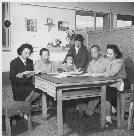 Japanese-American family makes plans to return to California home. The members of the Shikano family gathers around the crude table in their one-room barracks home at this Central Utah Relocation Center today and decide to leave for their Centerville, California, farm January 10. This will be one of the first evacuee families to return following revocation of the army's ban against persons of Japanese ancestry. Left to right: Mary, 24; Ichi, 61; Setsuye, 27, and her two-year-old daughter, Ritsuko; Ichizo, 67; Tomi, 25. The father of the little girl is in Centerville under special army permit making arrangements for their return. 1/3/45
|
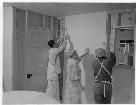 Volunteer carpenters placing the interior lining in one of the barracks at the Topaz Center . Contractor's work included finishing the exterior walls -- evacuee workers completed the interior lining. 10/18/42 |
 Scene as first group of Army volunteers leave for Fort Douglas, Utah, to be inducted. 5/5/43
|
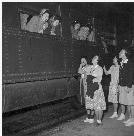 Girl reporters on the staff of the Topaz Times, publication of the Central Utah Relocation Center, interview new arrivals from Tule Lake through the car windows, while the latter are awaiting to detrain. 9/23/43 |
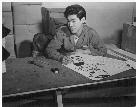 Bennie Nobori, former animator in a Hollywood film studio, is now a cartoonist on the Topaz Times. Bennie has a regular cartoon strip which appears in the paper at the Center, and is known as Jankee. 3/11/43
|
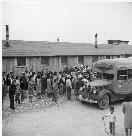 A crowd of Topaz residents is here shown at one of the mess hall assembly centers where they gathered to bid goodbye to friends and relatives leaving for the Tule Lake Center. 9/24/43 |
This camp was also known as the Abraham Relocation Center. It operated from Sept. 11, 1942 to Oct. 31, 1945. It's maximum population was over 8,000, making it one of the smaller camps. None of the buildings from the time remain although foundations of some of the buildings still exist.
From the Final Report: Japanese Evacuation From the West Coast, 1942, dated June 5, 1943, a description of the site: "Located at Abraham, Utah, in Millard Country, this Project site comprises approximately 19,000 acres. Several thousand acres were in crop but the greatest portion was covered with greasewood brush. The land is generally quite level. Fourteen hundred acres were public domain, 8,840 were owned by Millard County and the balance was privately owned.
"The average rainfall here is about 8 inches, with the greater portion coming during the winter months. This area requires considerable irrigation to mature crops, normally between two and three acre-feet of waer per acr. To provide for the water needs in connection with the farming planned for this project, the Division Engineer, Mountain Division, has purchased 20,000 shares of water stock in teh Abraham and Desert Water Company."
Everything has a beginning
 The Hammond Times, Feb. 26, 1943 |
A positive spin type of article
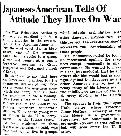 The Sheboygan Press, Jan. 28, 1944 |
Hurling charges
The United States knew very well that many of the camps run by the Japanese overseas were very, very bad and that many prisoners died, some of them in a brutal fashion. Tokyo wanted to detract attention from that and counter-charged that the Japanese in America were being tortured. Although there were some deaths and some beatings, nothing in the internment camps even began to get to the level of what happened in some of the camps run by the Japanese.
 The Times Record, Feb. 7, 1944 |
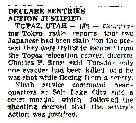 The Bismarck Tribune, Feb. 8, 1944 |
A "human interest" type of story
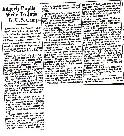 The Fitchburg Sentinel, Feb. 24, 1944 |
The Court says you can go, but most don't want to
The Supreme Court ruled that the evacuees, the loyal ones, anyhow, should be freed from the camps, but as the second article shows only a small number planned to return to the West Coast. This was due, of course, to the fact that the West Coast was still a very, very hostile place for Japanese Americans, and some who had already tried to go back had been met with violence and discrimination, and the word had gotten back to the people in the camps.
 The Oakland Tribune, Dec. 19, 1944 |
 same |
One of the more unusual stories
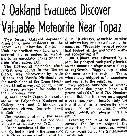 The Oakland Tribune, Dec. 20, 1944 |
And to all things there is an ending
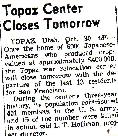 Reno Evening Gazette, Oct. 30, 1945 |
Topaz Times
Although there have been many books written about the Japanese-American internment, only some of them even mention the newsletters produced at the camps and, at most, they generally will have only one or two pages from one of the issues.
This is leaving out one of the most historically interesting and important aspects of the internment. The newsletters that were produced give the day-to-day news of interest to the community of those who were interned. I am sure that there were restraints on what the newsletters were allowed to print, but they still tend to contain a wealth of interesting material.
I ran across one particularly valuable source, Densho . They have a vast number of the newsletters. I found a few elsewhere.
I will put up either 5 or10 reviews at a time. There are over 400 newsletters, so it will take a while to get them all up.
The Topaz newsletters had a ten-issue run of Premiere issues before they actually started numbering the issues with volume and issue numbers.
Premiere Issues 1 through 5
Premiere Issues 6 through 10
Volume 1 #1-5
Volume 1 #6-10
Volume 1 #11-15
Volume 1 #16-20
Volume 1 #21-25
Volume 1 #26-30
Volume 1, #31-35
Volume 1, #36-40
Volume 1, #41-45
Volume 1, #46-50
Volume 2, #1-5
Volume 2, #6-10
Volume 2, #11-15
Volume 2, #16-20
Volume 2, #21-25
Volume 2, #26-30
Volume 2, #31-35
Volume 2, #36-40
Volume 2, #41-45
Volume 2, #46-50
Volume 2, #51-55
Volume 2, #56-60
Volume 2, #61-65
Volume 2, #66-72
Volume 3, #1-5
Volume 3, #6-10
Volume 3, #11-15
Volume 3, #16-20
Volume 3, #21-25
Volume 3, #26-30
Volume 3, #31-35
Volume 4, #1-5
Volume 4, #6-10
Volume 4, #11-15
Volume 4, #16-20
Volume 4, #21-25
Volume 4, #26-30
Volume 4, #31-35
Volume 4, #36-39
Volume 5, #1-5
Volume 5, #6-10
Volume 5, #11-15
Volume 5, #16-20
Volume 5, #21-25
Volume 5, #26-30
Volume 5, #31-36
Volume 6, #1-5
Volume 6, #6-10
Volume 6, #11-15
Volume 6, #16-20
Volume 6, #21-25
Volume 6, #26-30
Volume 6, #31-34
Volume 7, #1-5
Volume 7, #6-10
Volume 7, #11-15
Volume 7, #16-20
Volume 7, #21-27
Volume 8, #1-5
Volume 8, #6-10
Volume 8, #11-15
Volume 8, #16-20
Volume 8, #21-26
Volume 9, #1-5
Volume 9, #6-10
Volume 9, #11-15
Volume 9, #16-20
Volume 9, #21-24
Volume 10, #1-5
Volume 10, #6-10
Volume 10, #11-15
Volume 10, #16-20
Volume 10, #21-26
Volume 11, #1-5
Volume 11, #6-10
Volume 11, #11-15
Volume 11, #16-20
Volume 12, #1-5
Volume 12, #6-9
All Aboard, Spring 1944
Fighting Americans, Too
Topaz Trek December, 1942
Topaz Trek February 1943
Topaz Trek June, 1943
Volunteers for Victory, March 6, 1943
Bussei Life
You Tube Videos
Books on Topaz
The Children of Topaz: The Story of a Japanese American Internment Camp (Michael Tunnell)
Jewel of the Desert: Japanese American Internment at Topaz (Sandra C. Taylor)
Journey to Topaz
Main Index
Japan main page
Japanese-American Internment Camps index page
Japan and World War II index page
|
|